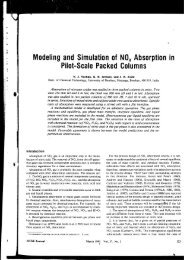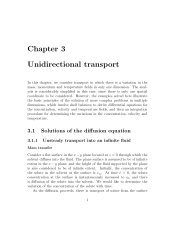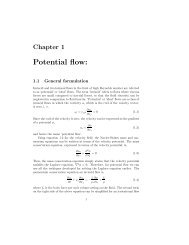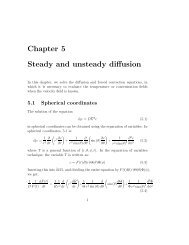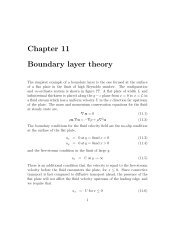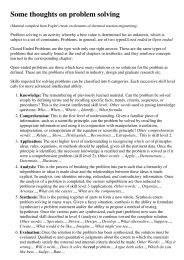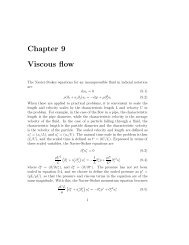Create successful ePaper yourself
Turn your PDF publications into a flip-book with our unique Google optimized e-Paper software.
16 CHAPTER 1. POTENTIAL FLOW:The radial and polar components of the velocity can be inferred using equation1.12,u r = U xR 2cos (θ)r 2u θ = U xR 2r 2 sin (θ) + Γ2πr(1.3)The above velocity field satisfies the condition u i n i = U i n i at the surface ofa cylinder with radius R, since the normal velocity u i n i , which is the radialvelocity u r in a polar co-ordinate system, is equal to U i n i = U x n x = U x cos (θ),where the component n x of the unit normal to the surface is equal to cos (θ).The force on the cylinder can be determined from the equation 1.17 for theforce on an object moving with velocity U i through the fluid,∫F i = ρS object= ρ∫ 2π0dSn i(u2j2 − U ju j)(Rdθ) n i( u2θ2 − U x(u r cos (θ) − u θ sin (θ))∣∣∣∣r=R(1.4)The ‘drag’ force F x , which is in the direction of the velocity, can be determinedusing n x = cos (θ) in equation 1.4,F x = ρ= ρ∫ 2π0∫ 2π0(Rdθ) cos (θ)(Rdθ) cos (θ)(12(12(U x sin (θ) +(U x sin (θ) +Γ ) 2+ U x (u r cos (θ) + u θ sin (θ)))2πRΓ ) 2+ Ux (cos 2 (θ) 2 − sin (θ) 2))2πR= 0 (1.5)As in three dimensions, the drag force due to the potential <strong>flow</strong> in two dimensionsis also equal to zero. The ‘lift’ force perpendicular to the direction of gravitycan be determined using n y = sin (θ) in equation 1.4,F x = ρ∫ 2π0(Rdθ) sin (θ)( (1U x sin (θ) +Γ ) 2+ Ux (cos 2 (θ) 2 − sin (θ) 2))22πR= ρU x Γ (1.6)1.4 Force on a two-dimensional object of arbitraryshape:The net force exerted on a two-dimensional object in potential <strong>flow</strong> can becalculated in a manner similar to that for a three-dimensional <strong>flow</strong>. A procedure







